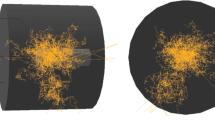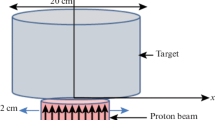Abstract
The Lead–Bismuth Eutectic (LBE) spallation target has been considered as one of the two alternatives for the spallation target for China Initiative Accelerator-Driven System. This paper reports the preliminary study on physical feasibility of a U-type LBE target with window. The simulation results based on Monte Carlo transport code MCNPX indicate that the spallation neutron yield is about 2.5 per proton. The maximum spallation neutron flux is observed at about 3 cm below the lowest part of the window. When the LBE target is coupled with the reactor, the reactor neutrons from the fission reaction increased the neutron field significantly. The energy deposition of high-energy protons is the main heat source; the spallation neutrons and reactor neutrons contribute only a small fraction. The maximum energy deposition in the LBE is about 590 W/cm3 and that in the target window is about 319 W/cm3. To estimate the lifetime of the target window, we have calculated the radiation damages. The maximum displacement production rate in the target window is about 10 dpa/FPY. The hydrogen and helium production rates generated during normal operation were also evaluated. By analyzing the residual nucleus in the target during the steady operation, we estimated the accumulated quantities of the extreme radioactivity toxicant 210Po in the LBE target loop. The results would be helpful for the evaluation of the target behavior and will be beneficial to the optimization of the target design work of the experimental facilities.















Similar content being viewed by others
References
C.D. Bowman, E.D. Arthur, P.W. Lisowski et al., Nuclear energy generation and waste transmutation using an accelerator-driven intense thermal neutron source. Nucl. Instrum. Methods A 320, 336–367 (1992). doi:10.1016/0168-9002(92)90795-6
Z. Wenlong, X. Hushan, Advanced fission energy program-ADS transmutation system. Bull. Chin. Acad. Sci. 27(3), 375–381 (2012). doi:10.3969/j.issn.1000-3045.2012.03.017
H.A. Abderrahim, J. Galambos, Y. Gohar et al., Accelerator and target technology for accelerator driven transmutation and energy production. DOE white paper on ADS, vol. 1, no. 1 (2010), pp. 1–23. http://192.107.175.200/~/media/hep/pdf/files/pdfs/ADS_White_Paper_final.pdf
T. Sugawara, K. Nishihara, H. Obayashi et al., Conceptual design study of beam window for accelerator-driven system. J. Nucl. Sci. Technol. 47(10), 953–962 (2010). doi:10.1080/18811248.2010.9720974
C. Fazio, F. Gröschel, W. Wagner et al., The MEGAPIE-TEST project: supporting research and lessons learned in first-of-a-kind spallation target technology. Nucl. Eng. Des. 238(6), 1471–1495 (2008). doi:10.1016/j.nucengdes.2007.11.006
A. Batta, A. Class, Numerical investigations on geometrical designs of the windowless XT-ADS spallation target, in International Congress on Advances in Nuclear Power Plants (ICAPP07), Nice, France, May. 13–18, 2007
J.B. Vogt, A. Verleene, I. Serre et al., Understanding the liquid metal assisted damage sources in the T91 martensitic steel for safer use of ADS. Eng. Fail. Anal. 14(6), 1185–1193 (2007). doi:10.1016/j.engfailanal.2006.11.075
W. Yican, Y. Bai, Y. Song, Q. Huang, Z. Zhao, H. Liqin, Development strategy and conceptual design of China lead-based research reactor. Ann. Nucl. Energy 87, 511–516 (2016). doi:10.1016/j.anucene.2015.08.015
D. Pelowitz, MCNPX User’s Manual 2.7.0 (Los Alamos National Laboratory, Los Alamos, 2011)
S.G. Mashnik, A.J. Sierk, K.K. Gudima et al., CEM03 and LAQGSM03—new modeling tools for nuclear applications. J. Phys: Conf. Ser. 41(1), 340 (2006). doi:10.1088/1742-6596/41/1/037
L. Chen, F. Ma, X.Y. Zhang et al., Spallation yield of neutrons produced in thick lead target bombarded with 250 MeV protons. Nucl. Instrum. Methods B 342, 87–90 (2015). doi:10.1016/j.nimb.2014.09.020
W. Lu, F.X. Gallmeier, P.J. Geoghegan et al., A reevaluation of radiation damage cross sections. J. Nucl. Mater. 431(1), 33–38 (2012). doi:10.1016/j.jnucmat.2011.12.016
M.S. Sabra, R.A. Weller, M.H. Mendenhall et al., Validation of nuclear reaction codes for proton-induced radiation effects: the case for CEM03. IEEE Trans. Nucl. Sci. 58(6), 3134–3138 (2011). doi:10.1109/TNS.2011.2169989
Y.E. Titarenko, V.F. Batyaev, R.D. Mulambetov et al., Excitation functions of product nuclei from 40 to 2600 MeV proton-irradiated 206,207,208, nat Pb and 209 Bi. Nucl. Instrum. Methods A 562(2), 801–805 (2006). doi:10.1016/j.nima.2006.02.059
M.B. Chadwick, P. Obložinský, M. Herman et al., ENDF/B-VII. 0: next generation evaluated nuclear data library for nuclear science and technology. Nucl. Data Sheets 107(12), 2931–3060 (2006). doi:10.1016/j.nds.2006.11.001
D. Fan, Y. Yang, Y. Gao et al. Thermal-hydraulics design of the LBE spallation target system for CIADS, in 23nd International Conference on Nuclear Engineering (ICONE23), Chiba, Japan, May. 17–21, 2015
Y. Iwamoto, H. Iwamoto, M. Harada et al., Calculation of displacement cross-sections for structural materials in accelerators using PHITS event generator and its applications to radiation damage. J. Nucl. Sci. Technol. 51(1), 98–107 (2014). doi:10.1080/00223131.2013.851042
M.J. Norgett, M.T. Robinson, I.M. Torrens, A proposed method of calculating displacement dose rates. Nucl. Eng. Des. 33(1), 50–54 (1975). doi:10.1016/0029-5493(75)90035-7
Y. Dai, Y. Foucher, M.R. James et al., Neutronics calculation, dosimetry analysis and gas measurements of the first SINQ target irradiation experiment, STIP-I. J. Nucl. Mater. 318, 167–175 (2003). doi:10.1016/S0022-3115(03)00099-0
T. Obara, T. Miura, Y. Fujita et al., Preliminary study of the removal of polonium contamination by neutron-irradiated Lead–Bismuth Eutectic. Ann. Nucl. Energy 30(4), 497–502 (2003). doi:10.1016/S0306-4549(02)00089-0
A.J. Koning, D. Rochman, S. van der Marck et al., TENDL-2014: TALYS-based evaluated nuclear data library. ftp://ftp.nrg.eu/pub/www/talys/tendl2014/tendl2014.html
Z. Tong, Y. Dai, The microstructure and tensile properties of ferritic/martensitic steels T91, Eurofer-97 and F82H irradiated up to 20dpa in STIP-III. J. Nucl. Mater. 398(1), 43–48 (2010). doi:10.1016/j.jnucmat.2011.04.029
Acknowledgments
The authors would like to express their thanks to the colleague in INEST for having provided us with the design scheme of CLEAR-I.
Author information
Authors and Affiliations
Corresponding author
Additional information
This work is supported by Strategic Priority Research Program of Chinese Academy of Sciences under Grant Number of XDA03030102.
Rights and permissions
About this article
Cite this article
Zhang, L., Yang, YW. & Gao, YC. Preliminary physics study of the Lead–Bismuth Eutectic spallation target for China Initiative Accelerator-Driven System. NUCL SCI TECH 27, 120 (2016). https://doi.org/10.1007/s41365-016-0114-6
Received:
Revised:
Accepted:
Published:
DOI: https://doi.org/10.1007/s41365-016-0114-6




